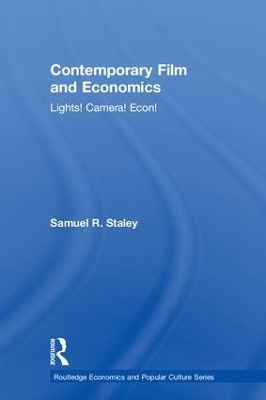
Contemporary Film and Economics
Lights! Camera! Econ!
Seiten
2018
Routledge (Verlag)
978-0-8153-6703-1 (ISBN)
Routledge (Verlag)
978-0-8153-6703-1 (ISBN)
What does the movie Lion tell us about why some societies grow rich and others remain poor? What can the box office juggernaut Jurassic World tell us about entrepreneurs and the ethics of business? This book surveys nearly 40 movies to answer these questions and explore key economic concepts such as profit maximization, greed, and monopoly.
What does the movie Lion tell us about why some societies grow rich and others remain poor? What can the global box office juggernaut, Jurassic World tell us about entrepreneurs and the ethics of business? Can the movie Passengers give us insight into human motivation and decision making? This book surveys more than 40 movies to answer these questions and much more.
Movies do more than entertain. They project important insights, often unintentional, into the way the world works and the values society cares about. Indeed, their stories are often grounded in the real-world experiences of everyday people. As part of this, movies also provide a window into understanding and evaluating economic behavior. Economics is, after all, the study of how scarce resources like labor, capital, and technology are used to improve (or reduce) our welfare. It also helps us to more fully understand the consequences in our lives that result from those choices and decisions. Through exploring a wide range of films from Passengers to Victoria and Abdul, this book delves into economic concepts such as opportunity costs, profit maximization, greed, business ethics, monopoly, economic growth, and entrepreneurship.
Contemporary Film and Economics is a must read for anyone interested in how movies project and interpret economic ideas, craft popular narratives for how economies operate, and explore motivations for economic behavior. Economists will find it useful in starting discussions on key concepts, while filmmakers will find the discussions of economic concepts a provocative way of thinking about how to craft engaging stories that are grounded in practical experience.
What does the movie Lion tell us about why some societies grow rich and others remain poor? What can the global box office juggernaut, Jurassic World tell us about entrepreneurs and the ethics of business? Can the movie Passengers give us insight into human motivation and decision making? This book surveys more than 40 movies to answer these questions and much more.
Movies do more than entertain. They project important insights, often unintentional, into the way the world works and the values society cares about. Indeed, their stories are often grounded in the real-world experiences of everyday people. As part of this, movies also provide a window into understanding and evaluating economic behavior. Economics is, after all, the study of how scarce resources like labor, capital, and technology are used to improve (or reduce) our welfare. It also helps us to more fully understand the consequences in our lives that result from those choices and decisions. Through exploring a wide range of films from Passengers to Victoria and Abdul, this book delves into economic concepts such as opportunity costs, profit maximization, greed, business ethics, monopoly, economic growth, and entrepreneurship.
Contemporary Film and Economics is a must read for anyone interested in how movies project and interpret economic ideas, craft popular narratives for how economies operate, and explore motivations for economic behavior. Economists will find it useful in starting discussions on key concepts, while filmmakers will find the discussions of economic concepts a provocative way of thinking about how to craft engaging stories that are grounded in practical experience.
Samuel R. Staley is an urban economist and director of the DeVoe L. Moore Center in the College of Social Sciences and Public Policy at Florida State University, USA. He is also a research fellow with the Independent Institute in Oakland, California as well as a public policy analyst, film critic, and award-winning novelist.
Chapter 1. The Economics in Film, Chapter 2. A Passage to Choice, Chapter 3. The Economics of Greed, Entrepreneurship, and Innovation, Chapter 4. The Labor Market Costs of Crime, Pride, and Prejudice, Chapter 5. Financing the Housing Crisis and the Great Recession, Chapter 6. The Nature and Causes of Wealth in Film, Chapter 7. Government Without Romance, Chapter 8. Conclusion: The Economics Behind the Story
| Erscheinungsdatum | 13.09.2018 |
|---|---|
| Reihe/Serie | Routledge Economics and Popular Culture Series |
| Zusatzinfo | 7 Tables, black and white |
| Verlagsort | New York |
| Sprache | englisch |
| Maße | 156 x 234 mm |
| Gewicht | 453 g |
| Themenwelt | Sozialwissenschaften ► Kommunikation / Medien ► Medienwissenschaft |
| Wirtschaft ► Volkswirtschaftslehre ► Makroökonomie | |
| Wirtschaft ► Volkswirtschaftslehre ► Mikroökonomie | |
| ISBN-10 | 0-8153-6703-1 / 0815367031 |
| ISBN-13 | 978-0-8153-6703-1 / 9780815367031 |
| Zustand | Neuware |
| Haben Sie eine Frage zum Produkt? |
Mehr entdecken
aus dem Bereich
aus dem Bereich
wie KI und virtuelle Welten von uns Besitz ergreifen – und die …
Buch | Hardcover (2023)
Heyne (Verlag)
CHF 29,90
eine jüdische Filmgeschichte der Bundesrepublik
Buch | Hardcover (2023)
Hanser (Verlag)
CHF 39,20


